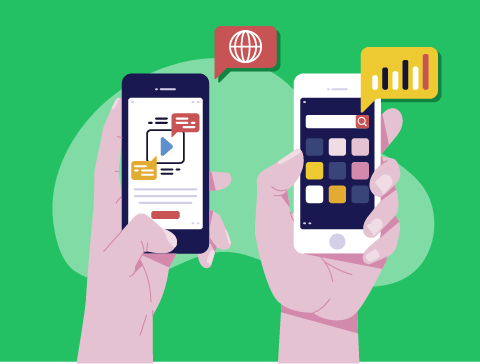Introduction
Increasingly, we’ve seen traditional media being put under pressure due to the growth of new media.
New media has gained huge popularity in the last few decades due to technological developments such as the internet, social media, and streaming.
In this lesson, we will learn about:
- What new media is
- The different types of new media & how they’re evolving
What New Media Is
New media includes any form of digital media content.
This can include anything that can be viewed online, from adverts to social media posts, but includes digital content viewed offline, like video games.
Some examples of new media channels include:
- Computer games
- Interactive media
- Internet
- Digital publishing

What New Media Is
While new media is less tried and tested than traditional media, it has become a massive part of the media industry because it offers several benefits.
For example, new media is often more interactive, can target our audience more effectively, and provides a much broader global reach for our media.

The Types of New Media
Every sector of the media industry produces a particular kind of media.
For example, the publishing industry produces media such as books, newspapers, magazines, and comic books.
Each new media industry has its own benefits and challenges.
It is also constantly growing and evolving to keep up with current demands, trends, and technology upgrades.
Let’s look at the four types of new media and how they’re evolving.

Computer Games
The computer gaming industry is one of the most profitable media industries in the UK.
The UK market for video games reached a record £7bn in 2020, making it one of the largest employers within the creative industries.
The first computer games were developed in the 1950s & 60s, and the first popular video game was developed at MIT in 1962 and was called “Spacewar!”.
This game would seem very basic and low quality for us to play now, but at the time, it was a ground-breaking development.

Computer Games
Over the years the computer games industry has had to evolve quickly to changing technologies.
The creation of console gaming systems, starting with the Magnavox Odyssey in 1972, brought video games into the home and helped create one of the biggest booms of content creation that the creative industry has ever seen.
From the 1980s to the 1990s, 3D video games were created, further increasing the popularity of this type of media.
In more recent years, virtual reality games were even launched using technology like the Oculus Rift.

Interactive Media
Interactive media industries produce content that consumers can actively participate in. This includes media such as mobile apps & digital kiosks.
Interactive media is a very broad area; the earliest examples of interactive media, though, were information kiosks.
The first kiosk was created in 1977 and we now see them used in many places, such as airports, fast food self-service tills, museums and more.
Mobile apps were first created in 1997, with “Snake” commonly seen as the first app.
We now have complex apps with high-definition graphics, touchscreen interfaces & a wide variety of functions and uses.

Interactive Media
Interactive media is constantly growing and evolving to keep up with current technologies.
A recent development in interactive media is interactive television.
Interactive television includes Smart TV where you can install applications on the television, use voice control commands and even video chat.

Internet
The internet is a form of new media we all use day to day.
We consume media via the internet by using services such as email, social media, websites, internet-based television and radio, and more!
The internet was first launched in 1983 and created the ability for computers to be a part of a network and share information.
The internet has been constantly growing and developing since then, with the first website launched in 1991 by Sir Tim Berners Lee.
Initially, websites were simply plain text with hyperlinks. However, over time, this has evolved to include features like images, special effects and dynamic content.

Internet
The newest development is social media.
Social media has completely changed the way that we consume internet media, it has blended both interactive and internet media into one.
The first social media website, SixDegrees, was released in 1997. The current largest website, Facebook, has 2.5 billion monthly users.
Another recent development is streaming sites, which have been important in the evolution of many forms of traditional media.
The first popular video-streaming website was YouTube, which launched in 2005.

Digital Publishing
The publishing industry has traditionally been based on producing physical documents for distribution. It is one of the oldest and most reliable forms of media.
However, in recent years, popularity has declined because younger generations are less interested in newspapers and magazines.
This has forced the publishing industry to evolve and adapt by producing digital publishing.
Digital publishing can include eBooks, digital magazines, digital newspapers and online shopping catalogues.

Digital Publishing
The first digitally published document was in 1971 and was The Declaration of Independence, published through Project Gutenberg.
In 1993, Adobe created a new document format called PDF.
This format became extremely important for distributing digital documents and was a major development in digital publishing.
Perhaps the most notable development is the rise of e-books, particularly since the launch of the Amazon Kindle in 2007.
Amazon now sells more e-books than print books.

Lesson Summary
New media includes any form of digital media content.
The four sectors of new media are computer games, interactive media, internet and digital publishing.
Computer games are evolving with powerful game consoles and new technologies like VR.
Interactive media is a broad and evolving area that can include websites, mobile apps & kiosks.
The internet covers a wide range of media that is ever-changing, like websites, social media and streaming.
Digital publishing is one of the newest media sectors and includes eBooks, digital magazines, digital newspapers and online shopping catalogues.

